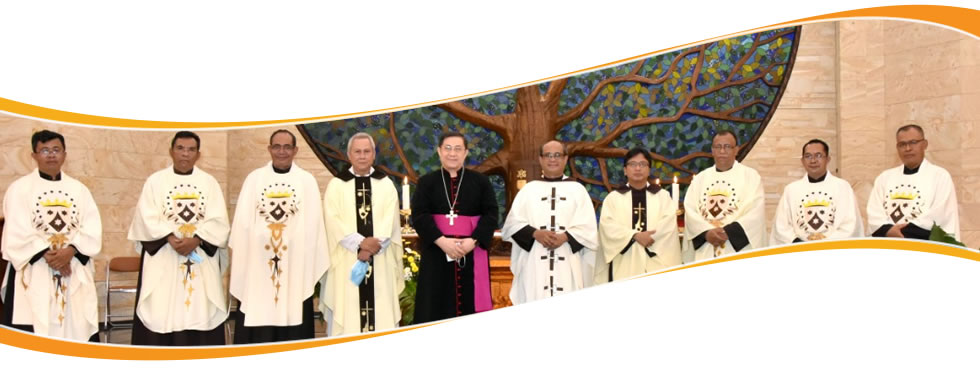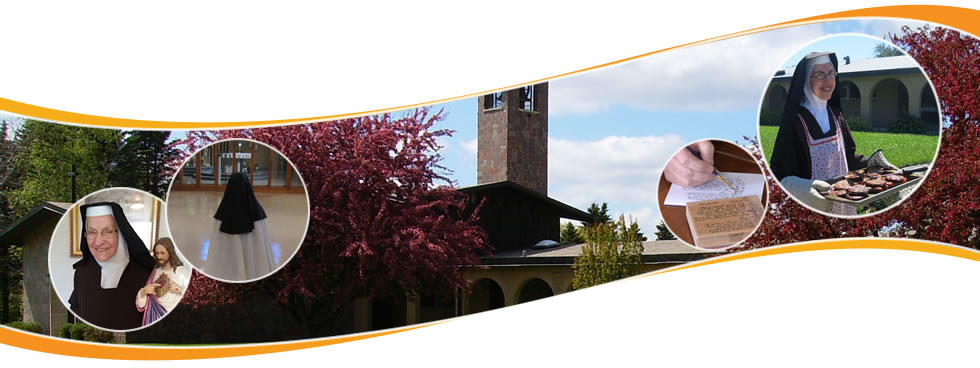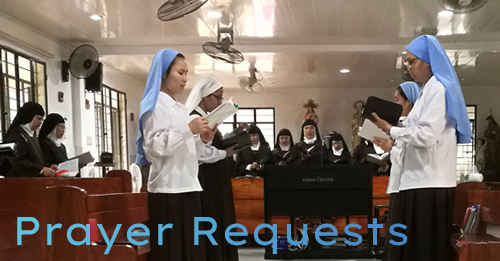Ernest E. Larkin, O.Carm.
“We need no wings to go in search of God, but have only to find a place where we can be alone and look upon Him present within us.” These words were written by St. Teresa of Avila in her book The Way of Perfection.
St. Teresa of Avila learned as a small child that one had to die in order to see God. Little Teresa wanted to see God. Practical and courageous by temperament she devised a scheme. She and her brother, Rodrigo, would go to the land of the Moors. There they would surely be martyred and Heaven would receive them. Very early one morning the two children stole away from their home and crossed the bridge leading out of Avila. But the plan soon ran into trouble. An uncle who happened to be entering Avila at the time, met the children, heard their fantastic plan and unceremoniously returned them to their parental dwelling.
Later on in life St. Teresa realized that one does not have to die to see God. “We need no wings to go in search of Him,” she wrote, “but have only to find a place where we can be alone and look upon Him present within us.”
These words of the saint contain three essential steps for fruitful mental prayer.
First, we must be searching for God; second, we must be willing to be alone with Him, and third, we need but look upon Our Lord Who is present within us.
At first sight, this advice might seem too general or too obvious to be of practical help in mental prayer, but the three steps go to the heart of the matter. St. Teresa is the antidote for those who can’t see the forest for the trees. With a woman’s intuition she cuts through the accidental and points out the essential conditions for mental prayer. Let us look at each of these principles in some detail.
First, we must be searching for God.
If God is just a name, if His love for us is an abstract truth which we believe but do not realize, we will hardly search for Him.
Mental prayer is too difficult for that. It will lack appeal. If, on the other hand, we are convinced that God is in Teresa’s words “a better prize than any earthly love,” if we realize that we actually have within us something incomparably more precious than anything we see outside, then we will desire to enter within ourselves and to seek God. When we are convinced that He cares for us and waits for us, we will have the security and the courage to love Him in return.
Mental prayer makes no sense to the loveless soul. Other prayers, for example, petitions or thanksgiving, even liturgical worship, can be said with little or no conscious love of God. Not so mental prayer. It is by definition in Teresa’s view nothing but friendly conversation with Him Who we know loves us. “The important thing in mental prayer,” she says, “is not to think much but to love much.” Mental prayer becomes passable when we realize the gift of God dwelling within our soul. Referring to her earlier years in religious life, St. Teresa wrote these regretful words, “I think that if I had understood then as I do now that this great King really dwells within a little palace of my soul, I should not have left Him alone so often and never allowed his dwelling place to get so dirty.” Mental prayer, you see, is nothing but our side of friendship with God—our “yes” to God’s call and invitation
This leads us to the second principle of St. Teresa’s advice. The willingness to spend time alone with God. For this saint, prayer is the way of perfection, the door to God’s great favors. “Once this door is closed,” she writes, “I do not see how He will bestow His favors
for though He may wish to take His delight in the soul and give the soul delight, there is no way for Him to do so since He must have it alone and pure and desirous of receiving His favors.” Teresa herself closed this door for one year of her life, during the long 18-year period of mediocrity which she describes as a struggle to reconcile these two contradictory things: the life of the spirit and the pleasures of the senses.
Teresa wanted God, but at the same time she was unwilling to give up certain little selfish habits, petty attachments that were displeasing to God. Giving up mental prayer was not the answer to this problem. It was almost a fatal mistake because this way is the only way to victory over ourselves and surrender to God. At the time she excused herself from prayer on the plea of ill health, but in her heart she knew the dishonesty of this reason. “One needs no bodily strength for mental prayer,” she wrote later, “but only love and the formation of a habit.”
Love, as we have seen, is the root. But let us be sure we know what this love is. Too many confuse being loved with love itself. Love is outgoing, unselfish, active. It means giving rather than self-seeking. It strives to please rather than be pleased. Listen again to St. Teresa: “Perhaps we do not know what love is. It would not surprise me, for love consists not in the extent of our own happiness, but in the firmness of our determination to please God in everything.” This kind of love moves us to spend time alone with God, not for what we get out of it, but for what we can put into it. We don’t go to mental prayer to feel good or enjoy a spiritual experience. These are secondary aspects at best. We go to protest our desire to accept God’s love, to allow Him to take over in our lives.
It is accidental whether we are delighted with consolation or tortured by dryness and desolation, whether holy thoughts and affections pour out of our hearts, or our minds are dull, sterile and unproductive.
Some of the best prayers are said when we don’t feel like praying, when we are tired and sluggish or burdened with self-pity and depression. When we are heavy, so opaque, so closed in on ourselves that only a heroic effort of our will keeps us kneeling at our prayer. It is this will to be alone with God and to talk with Him that distinguishes true prayer from delusion, because this will is the love of God.
Such love forms the habit of prayer. It makes us faithful to mental prayer day in and day out, in times of fervor as in times of coldness. It makes us choose God rather than ourselves outside prayer as well as in prayer, a choice that will be evident in our acts of fraternal charity, generosity, humility. This attachment to God and detachment from ourselves will measure the perfection of our prayer. As our life goes, so goes our prayer, and as our prayers, our life. We pray as well as we live and we live as well as we pray.
If we would improve then, where do we begin? Where shall we start? St. Teresa gives us the answer. It is the same answer that Our Lord gave in the Gospels: Perseverance, faithfulness, the formation of a habit. She would heartily endorse, I am sure, this thought of Dom Chapman: “If you want to pray well, then pray much. If you don’t pray much at least pray regularly and you will pray well.”
But one practical question remains. How? How shall I go about making mental prayer?
St. Teresa’s third principle is the answer. Simply look upon God present within your soul. The saint repeats this suggestion in many different ways. We are to fix our mind on the person of God, cultivate the sense of His Presence, have the realization of Whom we are addressing. This is her secret. You will find no new method of mental prayer in St. Teresa, no structuring of preludes and points. She is silent on these matters not because she is against them, but because she
reduces mental prayer to its simplest terms.
To certain nuns of her convent who objected that mental prayer was beyond their ability she wrote: “I am not asking you now to think of Him or to form numerous conceptions of Him, or to make long and subtle meditations with your understanding. I am asking only to look at Him.” It is as simple as that.
“Beginners,” she says, “do well to form an appealing image of Christ in His Sacred Humanity. They should picture Him within themselves in some mystery of His life, for example, the Christ of the agony or the Risen Savior in His glorified Body. Once they are conscious of Our Lord’s presence within their souls they need only look upon Him and conversation will follow. This friendly conversation will not be much thinking but much loving, not a torrent of words, much less a strained prepared speech, but rather a relaxed conversation with moments of silence as there must be between friends.”
This is the way St. Teresa prayed from the beginning. She simply gave her full attention to the Divine Guest within her soul and let her thoughts and sentiments take their course. At times she would console Our Lord for His suffering. At other times rejoice with Him in His Resurrection Sometimes her prayer would be affective, that is, made up of numerous acts of faith and hope and charity, humility and the other virtues. Other times it was contemplative. It was a simple lingering look of love that had the very feminine quality of blissful admiration.
But perhaps this way of prayer does not appeal to you. Such prayer, you may say, is all well and good for contemplatives, but I need a more active prayer, a more busy prayer. I must think through a mystery of Faith, make certain definite acts of my mind, work up concrete resolutions. I must follow a methodical meditation or I am doomed at prayer. To this I say well and good. Each one of us must pray the way God gives him to pray, but does not this simplified method of
St. Teresa meet the real needs of many? Are there not many among you who cannot meditate but who can pray?
In any case, St. Teresa’s teaching reminds all of us of what is truly essential in prayer, especially that it is a person-to-person contact between intimate loving friends. St. Teresa did in fact envy those who could meditate. She saw the value of extended reflections and dynamic dramatization on events of Our Lord’s life. She well knew that thoughts and images rouse up the will and incite lively sentiments of the virtues, but at the same time she knew that the essence of mental prayer lies on a deeper level than our own reflections and thinking, that real prayer exists when one strives to make contact with God whatever success is had, and that the measure of prayer’s perfection is the love that inspires it. And so St. Teresa prayed the only way she could, suffering the increased difficulties that were bound to come from the fact that the imagination, the memory and the intellect were not given a methodical plan of action.
She would use supports wherever she could find them. In books, for example, or in the beauties of nature, even in holy cards. Books were her standby. She never began mental prayer without some reading to collect her thoughts and put herself in the atmosphere of prayer. She returned to the book as often as needed in the course of the prayer. Daily spiritual reading assumed special importance because of the relative lack of reflection at prayer itself. Vocal prayers, like the Our Father, said slowly and with an effort to “taste” each phrase were also employed to express her love of God. But the starting point and the way to her whole system lay simply in looking at the Lord present in her soul.
In the beginning His Presence would be recognized by an act of faith expressed and made graphic in the dress of a picture of Our Lord. With growth in the spiritual life, in faithand hope and charity, and hence in prayer itself, the sense of His Presence would become more profound, more realized, more experiential. At all times this loving union with the Indwelling God was the immediate goal of her prayer. It should be your goal at prayer, and you will more quickly~ and more surely attain this union with God if you take to heart the discovery of St. Teresa of Avila:
“We need no wings to go in search of Him, but have only to find a place where we can be alone and look upon Him present within us.”
































